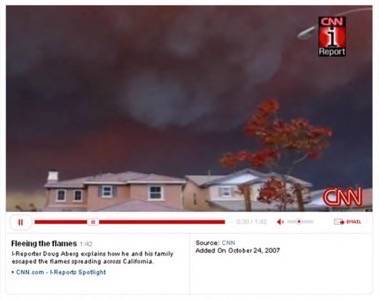It’s interesting to see how the techniques and technologies of amateur, citizen journalists are adopted, co-opted, and integrated by the mainstream media. Take blogs, for example, which earlier in this decade seemed like just an outlet for amateur web publishers. Fast forward a few years and you’ll be hard pressed to find any mainstream news source that doesn’t embrace blogging in some way — CyberJournalist.net lists 245 blogs run by mainstream news sites.

Earlier this week Nokia and Reteurs announced that they had partnered to create the ‘Mobile Journalism Toolkit,’ which teams a Nokia N95 cell phone with a keyboard, small tripod, and solar charger — technologies often used by amateurs to capture local news. The toolkit has been deployed to select Reuters journalists to help them file stories from the field and use the cell phone’s camera to take photos and videos of news events. “By running on handheld devices, rather than on bulkier laptop computers, the mobile journalism application enables us to create complete stories and file them for distribution, without leaving the scene,” said Nic Fulton, Chief Scientist at Reuters.
For now, the toolkit is aimed at professional journalists, however Nokia acknowledged that citizen journalists themselves, not just their techniques, are being more often relied upon by mainstream news outlets. “‘Citizen journalism’ is beginning to embrace a wide range of public engagement with the media,” said Timo Koskinen, project manager with Nokia Research Center, “from groups of contributors organized around subject or geographic areas to the casual participation of observers who are lucky – or unlucky – enough to be at the scene of a newsworthy event.”

Current events in California have made the emerging symbiotic relationship between citizen journalists and the mainstream news media quite apparent. In order to report on the fires ravaging that part of the United States, many news outlets have solicited, and subsequently used, submissions from people capturing news with cell phone cameras and on blogs (and Twitter, Flickr, YouTube, etc.). Multimedia platform Veeker, which last week signed a deal with NBC to handle viewer uploads in 10 major cities, said that NBC San Diego recieved over 2000 submissions of pictures and video related to the wildfires. CNN’s I-Reports section reportedly received about the same number of fire-related submissions (up dramatically from the number of submissions it received about the Virginia Tech shootings or the Missouri bridge collapse earlier this year). Note: Veeker has an interesting analysis about what they think made the citizen journalism efforts of NBC San Diego so successful on their blog.
“The real contribution of citizen journalists in a story like this, where whole areas of land are closed off and the fields of greatest danger keep shifting, is in having more eyes on the ground,” Thomas Hollihan, a professor of media at the Annenberg School of Communication at the University of Southern California, told the Baltimore Sun. “Citizen journalists are swapping information back and forth – reporting where the flames are now headed or showing images on their cell phones of the fire. And with so much happening so quickly, that kind of information can be really powerful – if it is accurate.”
Perhaps the biggest development in the citizen journalism space this year was the acquisition of Newsvine by MSNBC earlier this month. The news network framed the deal in terms of adding social features to MSNBC properties (“Coming together allows us to take advantage of the tremendous market opportunity to expand social media and community features across all of our brands,” said MSNBC Interactive News President Charlie Tillinghast in a press release), but what it really gives the company is access to citizen journalists. The mainstream media clearly sees the value in tapping into the general populace to access a more extensive coverage network. When your viewers are your reporters, you can have the news covered wherever it breaks.










